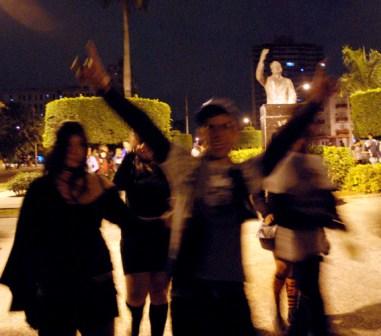Mindsets and Globalized Subcultures
By Dmitri Prieto

Recently I read in the Russian press how a representative of the Orthodox Church of that country referred to the need for the Church to be involved in various youth subcultures (emos, gothics, rappers, rockers, etc.).
“Those groups are settings in which new cultural forms are being shaped, and as these have to do with creativity and with the spirit, the Church should embrace these groups and invite them into dialogue,” the clergyman said.
Recently concluding in Havana was the Extended National Council of the Hermanos Saíz Association (AHS), an organization that brings together and promotes creative Cuban youth: writers, artists, researchers, critics, communicators and cultural promoters.
Notwithstanding, according to my sources, that council simply ignored the existence of youth subcultures.
Globalization, and especially new digital communications technologies, provides fascinating means for cultural exchange, which in countries as geographically and spiritually distant as Cuba and Russia – as well as in many others – has fostered the appearance of similar youth subcultures over a very short time.
That emergence of new cultural groups – which began in the world abroad with the beatniks of the 1950s, later became universalized with the hippie movement, and then accelerated after the Internet caught the entire planet in its digital spider web – is a fact recognized today by the media and social researchers.
We are confounded by the young generation, with its “strange” ways of dressing and behaving, with their impenetrable slang and increasingly outrageous music.
In Cuba, a new sight appeared nearly three years ago. G Street, in the Havana neighborhood of Vedado, gradually began being taken over during the night (especially on Saturdays) by youths of all types.
To be accurate, “freekies” (heavy metal rock fans) and “rastas” had already begun assembling much earlier, despite their gatherings being frowned on by the police.
About two years ago law enforcement officers received precise orders not to intervene in the youth gatherings, except when there was well-founded cause, and a diverse and multicolored multitude soon populated nighttime G Street.
Today the “emos” are the ones who attract the most commentary and criticism from passers-by, just as they are the ones who most astonish journalists, documentary-makers and cultural researchers.
Their fondness for depressive psychic states and their strange forms of externalizing their feelings are seen as something contradictory with the cultural stereotype of “being Cuban.”
Added to this, they are sometimes discriminated against by disciples of other subcultures, like the “freekies,” rappers and “repas” (“reparteros,” or groups of youth from poor neighborhoods who listen to reggaeton and timba).
Newspapers such as Juventud Rebelde have published interesting journalistic studies on the new subcultures, and young cinematographers have recently filmed revealing, award-winning documentaries on the subject. Even social research centers like the University of Havana Psychology Department have begun socio-cultural studies on these new youth subcultures.
But almost all those studies, documentaries and newspaper articles distance themselves with an opinion of non-commitment, as if we are looking at those young people as if they were freaks, almost looking down on them, similar to how one looks at animals in the zoo.
However, as people endowed with a voice, the emos, Gothics, freekis, repas, etc., without a doubt have a lot to say to those who are not like them. Likewise, they are entitled to organize their spaces and have their place in society recognized. In short, dialogue is required; a dialogue that doesn’t exist.
The AHS is an organization that in previous times was able to generate dialogue with rockers and rappers (though only intermittently, to be frank). The Association’s relationships with these subcultures – ones older than the emos, today are not as their highest point.
This is because the prevailing vision is that the AHS should be devoted to the promotion of the “avant garde. The issue of what is and what is not this vanguard is decided on in environments in which people who don’t belong to the vanguard are excluded a priori. It is a closed circle.
But I still have hope that there are members or projects in the AHS with expertise and openness to dialogue with the new youth subcultures.
If such dialogue occurs, we won’t have to face the new paradox of globalization: one of a (very conservative) Russian orthodox church seeking out youth subcultures as settings of creativity vs. a (institutionally revolutionary) Cuban association of creative youth ignoring the very existence of such subcultures in their discussions.






You’re right about the serious lack of profound, living, emancipatory dialog in “socialist” Cuba from what I gather; but by the same token, this phenomenon of World-wide youth subcultures is a warped expression of a new World — & socialist, free — culture being born in the bowels of a still-hegemonic capitalism, crass with commercialism. So how to strike the proper balance, eh? For one thing: these are all moving targets; & so no one strategy will fit for all time in all situations, AFAIC. Improvization & constant re-jigging of the circumstances appears to be called-for. But isn’t that what the aftermath of socialist revolution was always going to be about?
These youth certainly need to be engaged with as free citizens of a socialist society; but you can’t ever lose sight of the fact either that the way they are pointing is only in some sense towards emancipation. In other important ways they are simply lost (for now?) to a Revolution which is itself faltering somewhat.